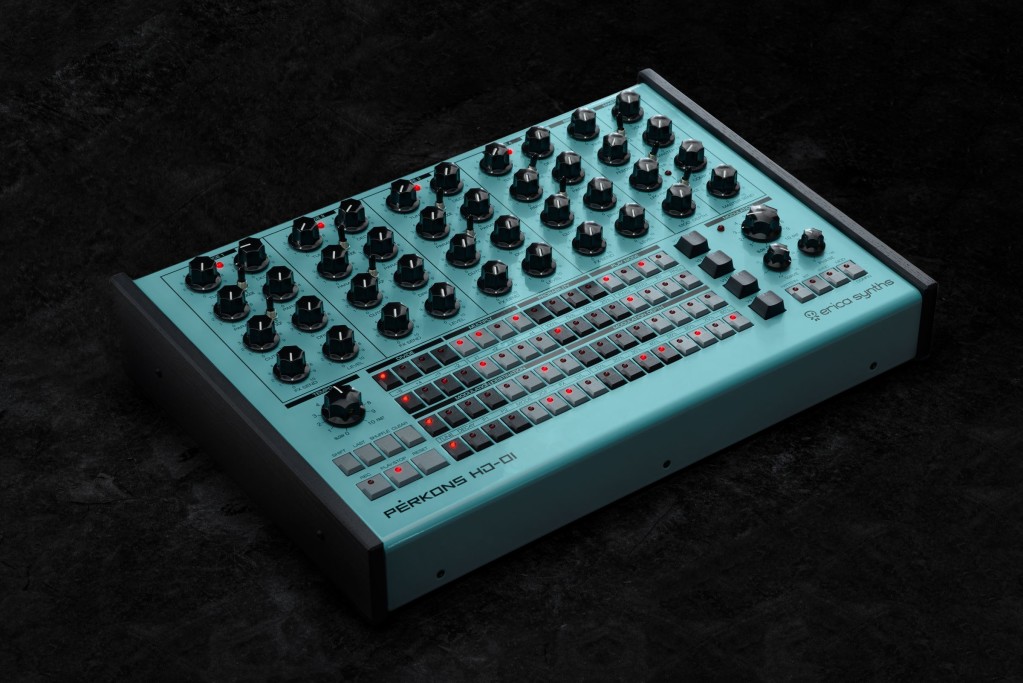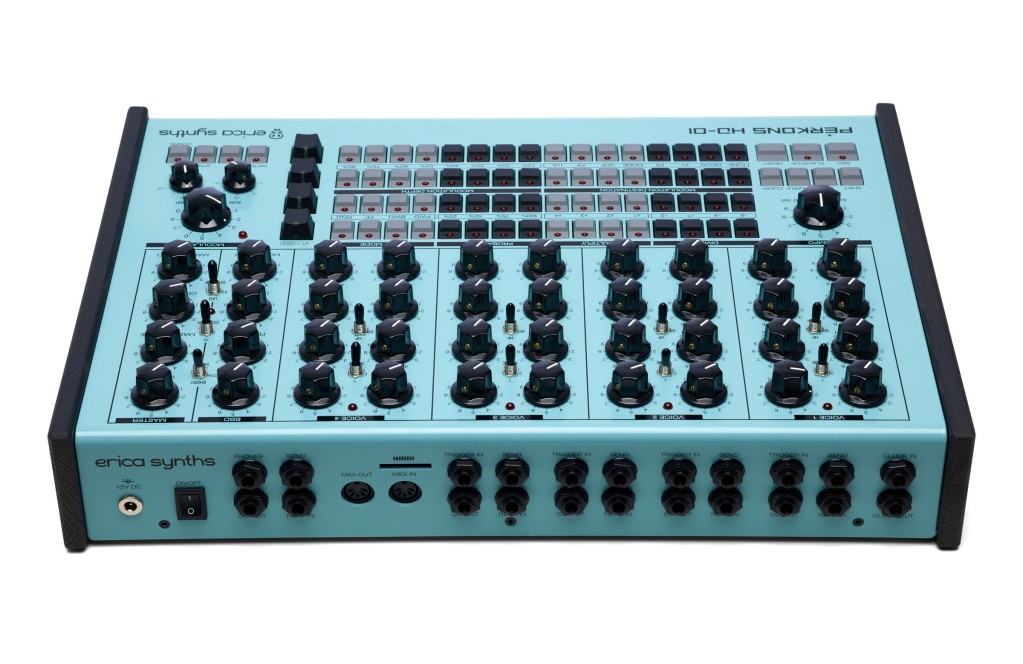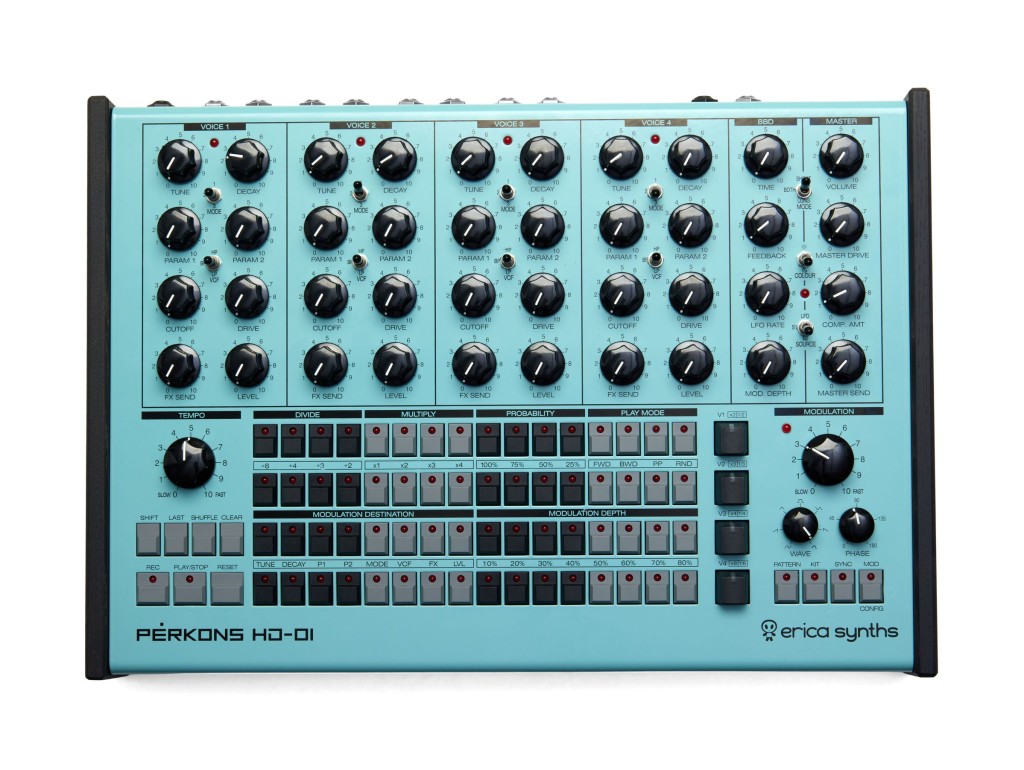Erica is offering up a 4-voice synth and percussion architecture with a detailed sequencer in a single box. So yeah, this week is about a lot of new modules – but PĒRKONS shows again how those ideas can be integrated into a single desktop design, too.
If the weather gets stormy, now we’ve learned some Latvian – pērkons means thunder, related to Perkūnas the Baltic deity who controls storms and symbolizes creativity. Just, uh, careful how you deploy that newfound knowledge as Latvian nouns are declined into seven cases, which takes some practice. (Take it from me, Pēteris. And… I’ll stop; that’s all I’ve got as a dumb American.)

PĒRKONS the machine is coming this year, Erica says. It’s got some characteristic Erica elements – multi-mode analog filters with overdrive, combined with their go-to bucket brigade delay effect, then summed through an optical compressor and master overdrive so you no doubt get a signature dark and stormy industrial-friendly sound. Overdrive per voice, overdrive overall. Overdrive overdrive.
And you can hook in velocity-sensitive pads and play this like a drum kit.
Specs (pics courtesy Erica, looks like we get product renders for that so I hope they do have some prototype – checking):


- 4 hybrid voices – so by hybrid, they mean the sound source itself is digital, but each of the four voices gets routed through independent analog multimode filter (LP/BP/HP) each with overdrive.
- 8 controls per voice – that’s notable, actually; you really get independent voices lined up a bit like modules would be (not accidentally, I think).
- Velocity-sensitive trigger inputs – so you can hook up drum pads and play that way. (Please. Let’s do that. I’m not a drummer and even I want to try that.)
- Individual voice outputs.
- Individual sends and returns – so you aren’t limited to the onboard delay effect. Big 6.3mm (1/4″) jacks, too.
- 64 kit and 64 pattern memory + additional memory on the SD card. With this you can save all voice parameters into the kit.
- Parameter automation throughout.
- Analog bucket brigade delay (BBD) as a send. That sound is all over Erica’s stuff.
- Optical compressor that sums the four channels.
- Modulation LFO with morphing waveforms, phase shift
- Route the LFO to eight destinations – see that push-button interface? (Eight destinations, by the way, is … all of the parameters.)
- 4 track sequencer, 4 time divisions and 4 time multiplications per track
- Per-step ratchets and probabilities
- 4 shuffle algorithms (will find out what that is)
- MIDI in / MIDI out
- Clock in / clock out.
Official pricing/availability:
RRP: 1650 EUR (VAT excl.)
MAP: 1999 USD
Release date within 2021
No preorders.

And the thing looks like it’ll be built like a tank. There isn’t a single minijack on it. It’s just a big, bright retro-blue metal beast. For all the dark things in our modern world, the manufacturing spots that once made Cold War military equipment now make violent drum machines. Wicked.
It’s hard not to notice that this box costs roughly the same as Moog’s triple-stack announced yesterday – just under two grand list US$. Now, it’s a totally unfair and maybe mostly irrelevant comparison. And sure, these are intended to do fundamentally different things and for fundamentally different people.
But all of us have some different internal personalities, anyway, so let’s observe some obvious stuff pretty quickly. First – you have about as much architecture here (sequencing and voice) as you do on the Moog, even if it’s fit into a smaller box, if not a little more (seriously).
There’s no question this is a purpose-built set of four voices. Something like that Moog – or a small modular – will give you some more open-ended ways of working, and you’ll wind up doing a lot of patching. (And for that, Erica’s integrated modular systems or lines of modules can do something similar for you, with more patching than Moog’s semi-modulars.)
On the other hand – having a single sequencer with all these features is very useful, as is having four dedicated voices you can deploy together with some integration. I know for one thing it is really useful to have multimode filters, and part of the problem with Moog is being stuck with ladder filters that sound nice all the time and are often lowpass only.
It is interesting at least to see the range of approaches in synths today and – cutesty stickers aside, the difference in sonic character. I know Erica’s circuits pretty well by now, and yeah, the one comparison that is not unfair is to say, the Erica box will cheerily sound dirty, angry, and industrial for you readily. Not to say you can’t drive each line the opposite way – clean Erica, dirty Moog. But –
Will the Moog often make it sound like you’re on a pleasant late 70s vinyl, or playing for some people in cardigans drinking tea on rugs in the USA? Will the Erica sound like it’s some dodgy rave afterhours and you’re in a dirty old Soviet-constructed electronics warehouse with some kids covered in sweat banging their heads to the overdriven drums?
Protams, protams.
So there’s the range we get today, and I’m glad for it.
Anyway, don’t worry if you can’t afford either. I’ll be back next week with the LXR-02 from Erica again and – they did a bunch of great stuff with the firmware. So stay tuned.
Stand by for some ‘sounds of Superbooth’ sound samples of this and other stuff, too, hopefully.